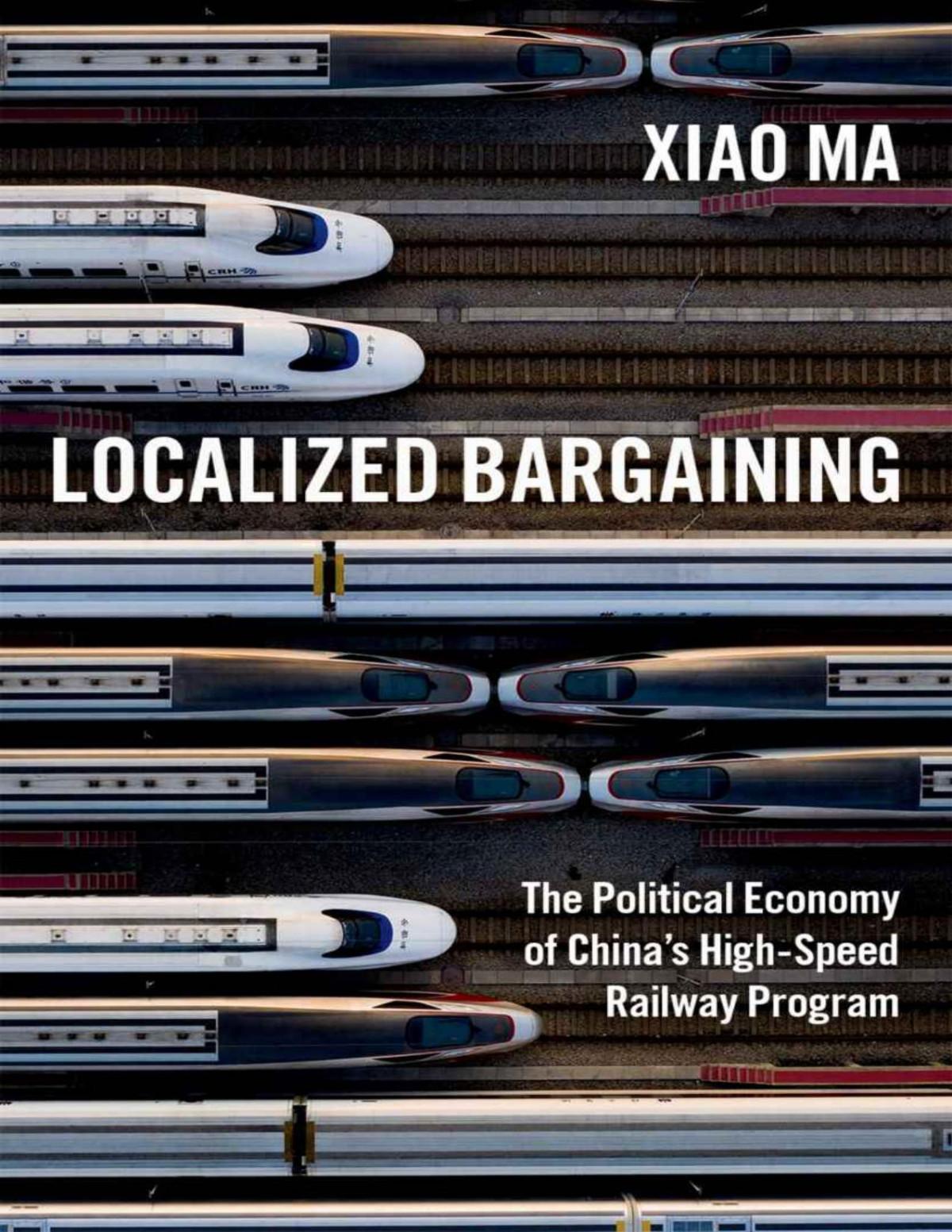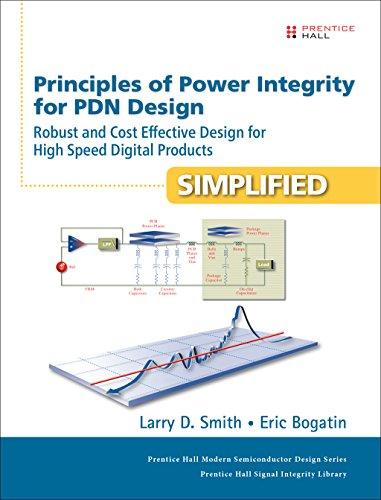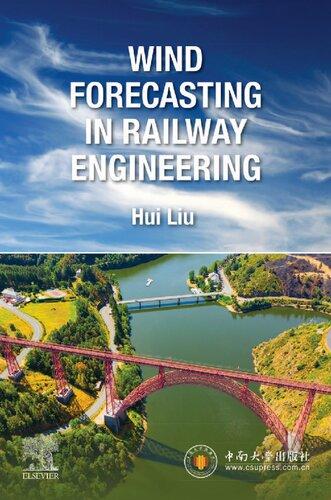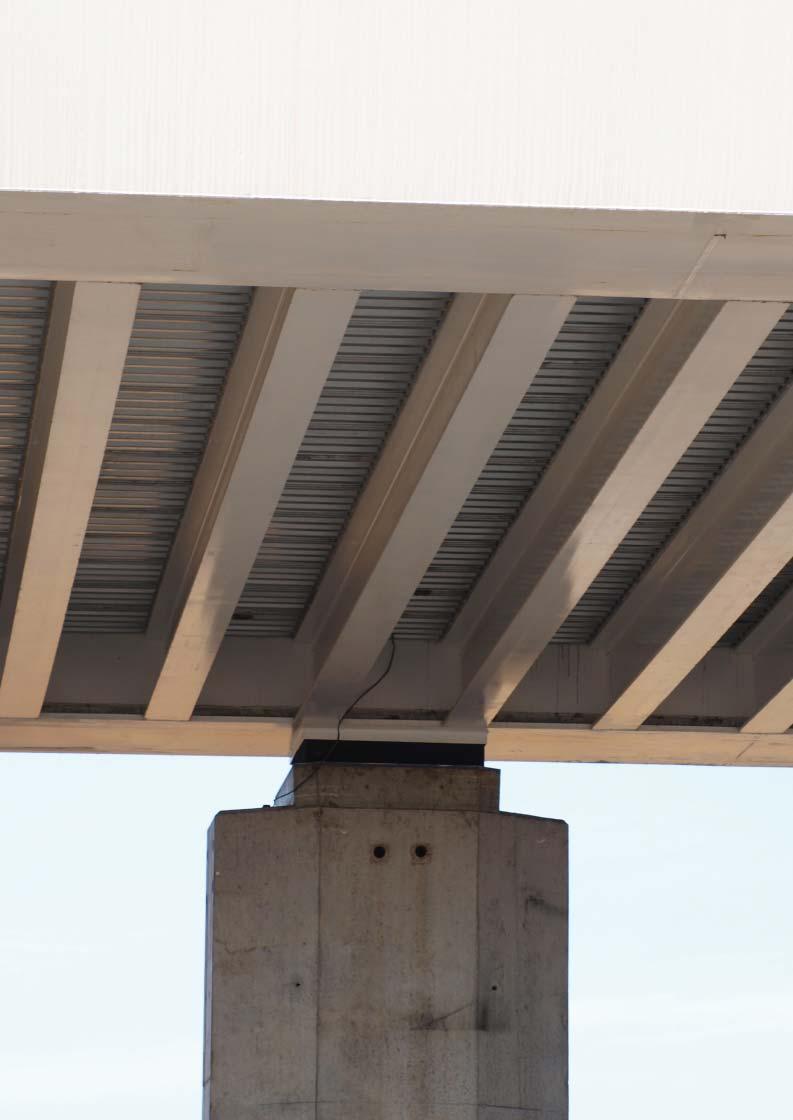High-speed Railway Bridges: Conceptual Design Guide José Romo
Visit to download the full and correct content document: https://ebookmass.com/product/high-speed-railway-bridges-conceptual-design-guide-j ose-romo/

More products digital (pdf, epub, mobi) instant download maybe you interests ...

Localized Bargaining: The Political Economy of China's High-Speed Railway Program. Xiao Ma
https://ebookmass.com/product/localized-bargaining-the-politicaleconomy-of-chinas-high-speed-railway-program-xiao-ma/

Principles of Power Integrity for PDN DesignSimplified: Robust and Cost Effective Design for High Speed Digital Products (Prentice Hall Modern Semiconductor Design) – Ebook PDF Version
https://ebookmass.com/product/principles-of-power-integrity-forpdn-design-simplified-robust-and-cost-effective-design-for-highspeed-digital-products-prentice-hall-modern-semiconductor-designebook-pdf-version/

Financial Determinants of High-Growth Companies: A Conceptual Model Blaž Frešer
https://ebookmass.com/product/financial-determinants-of-highgrowth-companies-a-conceptual-model-blaz-freser/

Dynamics of Coupled Systems in High-Speed Railways: Theory and Practice Weihua Zhang
https://ebookmass.com/product/dynamics-of-coupled-systems-inhigh-speed-railways-theory-and-practice-weihua-zhang/

Wind Forecasting in Railway Engineering Hui Liu
https://ebookmass.com/product/wind-forecasting-in-railwayengineering-hui-liu/

The Logic of Information: A Theory of Philosophy as Conceptual Design 1st Edition Luciano Floridi
https://ebookmass.com/product/the-logic-of-information-a-theoryof-philosophy-as-conceptual-design-1st-edition-luciano-floridi/

Vehicle scanning method for bridges Yeong-Bin Yang
https://ebookmass.com/product/vehicle-scanning-method-forbridges-yeong-bin-yang/

Bridges Burned (Mission Mercenaries Book 3) Marie James
https://ebookmass.com/product/bridges-burned-mission-mercenariesbook-3-marie-james/

The Oxford Guide to Middle High German Howard Jones
https://ebookmass.com/product/the-oxford-guide-to-middle-highgerman-howard-jones/

High-SpeedRailwayBridges
ConceptualDesignGuide
JoséRomo,AlejandroPérez-Caldentey,andManuelCuadrado
Authors
JoséRomo
AlejandroPérez-Caldentey FhecorIngenierosConsultores,S.A. Barquillo23 28004Madrid Spain
ManuelCuadrado FundaciónCaminosdeHierro CalleSerrano160 28002Madrid Spain
Cover: RiudellotsViaduct,Riudellotsde laSelva(Gerona),Spain Photographer/Copyright:JoséRomo Madrid,Spain
Thisbookwaskindlysupportedby:


Allbookspublishedby Ernst&Sohn are carefullyproduced.Nevertheless,authors, editors,andpublisherdonotwarrantthe informationcontainedinthesebooks, includingthisbook,tobefreeoferrors.Readers areadvisedtokeepinmindthatstatements, data,illustrations,proceduraldetailsorother itemsmayinadvertentlybeinaccurate.
LibraryofCongressCardNo.: appliedfor
BritishLibraryCataloguing-in-PublicationData Acataloguerecordforthisbookisavailable fromtheBritishLibrary.
Bibliographicinformationpublishedby theDeutscheNationalbibliothek TheDeutscheNationalbibliotheklists thispublicationintheDeutsche Nationalbibliografie;detailedbibliographic dataareavailableontheInternetat <http://dnb.d-nb.de>
©2024Ernst&SohnGmbH,Rotherstraße21, 10245Berlin,Germany
Allrightsreserved(includingthoseof translationintootherlanguages).Nopartof thisbookmaybereproducedinanyform–by photoprinting,microfilm,oranyother means–nortransmittedortranslatedintoa machinelanguagewithoutwrittenpermission fromthepublishers.Registerednames, trademarks,etc.usedinthisbook,evenwhen notspecificallymarkedassuch,arenottobe consideredunprotectedbylaw.
PrintISBN: 978-3-433-03313-5
ePDFISBN: 978-3-433-61040-4
ePubISBN: 978-3-433-61039-8
oBookISBN: 978-3-433-61038-1
CoverDesign: PetraFranke/Ernst&SohnGmbH usingadesignbySonjaFrank,Berlin,Germany Typesetting Straive,Chennai,India
Printedonacid-freepaper.
Contents
Foreword xv
AbouttheAuthors xvii
Acknowledgements xix
1IntroductiontoHigh-SpeedRailwayBridges 1 JoséRomo
1.1Book’sContent 1
1.2WhatisSpecialAboutaHigh-SpeedRailBridge? 2
1.2.1DynamicAmplificationandResonance 2
1.2.2RailTrafficSecurity 3
1.2.3Passenger’sComfort 3
1.2.4Track–StructureInteraction 4
1.3GeneralIdeasonHigh-SpeedRailwayBridges 4
1.4EvolutionandTrendsinHigh-SpeedBridgeDesign 6
1.4.1FirstHigh-SpeedBridges 6
1.4.1.1First-GenerationGermanBridges 6
1.4.1.2First-GenerationFrenchBridges 8
1.4.1.3First-GenerationSpanishBridges 8
1.4.2RecentHigh-SpeedBridges 9
1.4.2.1RecentFrenchBridges 9
1.4.2.2Second-GenerationGermanBridges 9
1.4.2.3RecentSpanishHSRB 10
1.4.2.4BridgesforHigh-SpeedRailwayLinesinChina 10
1.4.2.5BritishHigh-SpeedBridges 12
1.4.2.6High-SpeedRailwayBridgesintheUSA 12
1.4.3Conclusions 12
1.4.3.1Viaducts 13
1.4.3.2Long-SpanBridges 13
1.5TheLandscapeandtheDesignofHigh-SpeedRailwayBridges 13
1.5.1TheTraveller’sExperience 13
1.5.2TheBridgeintheLandscape 15
1.5.2.1LongViaductswithLowVerticalLevel 16
1.5.2.2LongViaductswithMediumorHighLevel 16
1.6RailwayBridgesasLandmarksorIconsofaLine 22
1.7RailwayBridge’sLegacy 23
1.8Buildingforthe21stCentury 24
1.9Conclusions 24 References 25
2TrackforHigh-SpeedBridges 29 ManuelCuadrado
2.1Introduction 29
2.2SpecificCriteriaforRailwayBridges 29
2.2.1GeneralCriteria 29
2.2.2SpecificCriteriaforHigh-SpeedBridges 31
2.3DescriptionoftheTrackSuperstructure 31
2.3.1TrackComponents:Definitions,Functions,andQualities 32
2.3.1.1Ballast 32
2.3.1.2Sleepers 32
2.3.1.3Fasteners 33
2.3.1.4Rails 33
2.3.1.5SwitchesandCrossings 34
2.3.2MostImportantConceptualImprovements 35
2.3.2.1ContinuousWeldedRail(CWR) 35
2.3.2.2Track–InfrastructureInteraction:BetterUnderstanding 36
2.3.3EvolutionoftheDifferentComponents 36
2.3.3.1Ballast 36
2.3.3.2Sleepers 37
2.3.3.3Fastenings 39
2.3.3.4Rails 40
2.3.4TrackOptionsCurrentlyAvailableforHighSpeed 41
2.3.4.1OptimisedBallastedTrack 41
2.3.4.2NewBallastlessTrack 43
2.4SLSRelatedtotheTrack 44
2.4.1DynamicInteraction:Track–Vehicle 44
2.4.2TrackGeometryQuality 46
2.4.3SLSVerificationsRegardingDeformationsandVibrations 48
2.4.3.1CriteriaforTrafficSafety 48
2.4.3.2ComfortCriteria 55 References 57
3ConceptualDesignofHigh-SpeedRailwayBridges 61 JoséRomo
3.1Introduction 61
3.2StructuralandFunctionalSpecificRequirementsforHigh-Speed RailwayBridges 62
3.2.1Introduction 62
3.2.2ControlofVerticalAcceleration 62
3.2.3RotationatExpansionJoints 62
3.2.4HorizontalBrakingandTractionForcesandRelativeMovements BetweenDeckandInfrastructure 62
3.2.5Track-BridgeDeckInteraction 63
3.2.6ExpansionJoints 63
3.3LongitudinalDesignStrategies 64
3.3.1GeneralConcepts 64
3.3.2BallastedTrack 65
3.3.3BallastlessTrack 66
3.3.4ActionstobeConsideredattheFixedPoint 66
3.4DesignSituationofHigh-SpeedRailwayBridges 66
3.4.1ShortCrossingatLowLevel 67
3.4.2LongStructures 67
3.4.2.1LowProfile 68
3.4.3High-LevelViaducts 71
3.4.4LongSpanStructures 72
3.5StructuralTypes 72
3.5.1StraightDeckSolutions 72
3.5.1.1SimplySupportedDeck 72
3.5.1.2ContinuousSlabConcreteDecks 73
3.5.1.3PrecastBeamDecks 74
3.5.1.4ConcreteBoxHollowSections 78
3.5.1.5SteelBeamDecks 80
3.5.1.6SteelSemi-throughDecks 81
3.5.2TrussBridges 82
3.5.3ArchBridges 83
3.5.3.1UpperDeckBridges 83
3.5.3.2TiedArchBridges 85
3.5.4Cable-SupportedBridges 85
3.5.4.1ExtradosedBridges 85
3.5.4.2Cable-StayedBridges 86
3.5.4.3SuspensionBridges 88
3.5.4.4HybridBridges 89
3.6StructuralElements–Substructure 89
3.6.1Abutments 90
3.6.1.1AbutmentswithExpansionJointinStructureOnly 90
3.6.1.2AbutmentswithExpansionJointinStructureandTrack 90
3.6.1.3FixedAbutments 91
3.6.2Piers 95
3.6.3Bearings 95
3.6.3.1GeneralBearingLayout 96
3.7SeismicDesign 99
3.7.1SeismicDesignStrategies 99
3.7.2SeismicBehaviourandDeckArticulation 99
3.7.3LongitudinalBehaviour 100
3.7.3.1SimplySupportedSpans 100
3.7.3.2ContinuousDeck 100
3.7.4TransversalBehaviour 101
3.7.4.1Introduction 101
3.7.4.2FixedTransversalSupport 101
3.7.4.3TransversalDampingSystems 102
3.7.4.4DampingDevicesPlusBearings 104
3.8WorkedExample 106
3.8.1Introduction:AimandData 106
3.8.1.1Topography 106
3.8.1.2PlanandElevation 106
3.8.1.3RailwayPlatformSection–ProjectSpeed 106
3.8.1.4WaterFloodLevel 107
3.8.1.5PreliminaryGeotechnicalData 107
3.8.2Methodology 107
3.8.3CriticalAnalysisofExistingInformation 107
3.8.4DeterminationoftheLengthoftheViaduct,SelectionoftheFixed Point 108
3.8.5SpanDistribution 109
3.8.6DeckPre-dimensioning 109
3.8.7Pre-designoftheInfrastructure 112
3.8.7.1FixedPoint 112
3.8.7.2Bearings 112
3.8.7.3Abutments 112
3.8.7.4Piers 113 References 115
4DesignBasis 117 JoséRomo
4.1Introduction 117
4.2DesignSituations 117
4.3RailTrafficActionsandOtherActionsSpecificofRailwayBridges 118
4.3.1PermanentLoads 118
4.3.1.1Self-Weight 118
4.3.1.2DeadLoads 118
4.3.1.3PartialBallastRemoval 119
4.3.2VariableLoads 119
4.3.2.1VerticalLiveLoads 119
4.3.2.2TractionandBrakingForces 121
4.3.2.3CentrifugalForces 122
4.3.2.4NosingForces 123
4.3.2.5AerodynamicActionsfromPassingTrains 123
4.3.2.6ThermalActions 123
4.3.2.7BearingFriction 124
4.3.3DynamicsEffects 124
4.3.3.1Introduction 124
4.3.3.2ConsiderationofDynamicEffects 125
4.3.4RailwayVehicleDerailment 125
4.3.4.1RailwayVehicleImpacts 125
4.4ApplicationofTrafficLoadsonRailwayBridges 126
4.4.1General 126
4.4.1.1LoadSituationsforStructuralDesign 127
4.4.1.2LoadSituationsforLimitStateandAssociatedAcceptance Criteria 127
4.4.2GroupsofLoads 127
4.4.2.1CharacteristicValuesofMulticomponentAction 127
4.5TrafficLoadsforFatigue 128
4.6VerificationsRegardingDeformationandVibrationsforRailway Bridges 128
4.7WorkedExample 129
4.7.1Introduction 129
4.7.1.1CalculationofReactionsatBearings:Pre-dimensioning 130
4.7.1.2CalculationofForcesandPreliminaryDesignoftheFixed Abutment 130
4.7.2Actions 130
4.7.2.1VerticalLoads 130
4.7.2.2HorizontalForces 131
4.7.2.3WindSpeed 132
4.7.3CalculationofReactionsatBearings:Pre-dimensioning 133
4.7.3.1VerticalForces 133
4.7.3.2CentrifugalForces 134
4.7.3.3WindatUnloadedState 135
4.7.3.4WindwithLiveLoad 135
4.7.3.5ReactionsinPierHeads 135
4.7.3.6TransversalWindBearingsReactions 136
4.7.3.7LoadsperBearings 136
4.7.4FixedAbutmentLoads 137
4.7.4.1Introduction 137
4.7.4.2LoadsTransmittedbytheDeck 137
4.7.4.3ForcesActingontheAbutment 138 References 140
5DynamicBehaviourofHigh-SpeedRailwayBridges 143 AlejandroPérez-Caldentey
5.1Introduction 143
5.1.1Resonance 143
5.1.2EnvelopeDynamicFactor 144
5.1.3DynamicFactorforRealTrainsObtainedbyMeansofAnalytical Formulations 145
5.1.4DynamicFactorObtainedbyDynamicAnalysis 147
x Contents
5.2MethodsforDynamicCalculationsandStructuralResponse 153
5.2.1ModalSuperposition 153
5.2.1.1MatrixFormulationforFiniteElementAnalysis 153
5.2.1.2FormulationBasedonAssumedEigenforms 155
5.2.2ResponsetotheIsolatedLoad 158
5.2.3ResponsetotheTrainLoads 162
5.2.4EffectofDamping 164
5.2.5DynamicInteractionBetweenVehicleandStructure 165
5.3Interoperability 167
5.3.1Introduction 167
5.3.2UniversalDynamicTrainA 167
5.3.3UniversalDynamicTrainB 167
5.4ApplicationExamples 168
5.4.1CaseWithoutDynamicAnalysis 168
5.4.2CasewithDynamicAnalysis 169 References 183
6LongitudinalTrack–StructureInteraction 185 ManuelCuadradoandAlejandroPérez-Caldentey
6.1Introduction 185
6.2ProblemStatement 185
6.3ModelforAnalysis 188
6.3.1GeneralConsiderations 188
6.3.1.1Rails 189
6.3.1.2Deck 189
6.3.1.3InteractionBetweenRailsandTrackBase 189
6.3.1.4Bearings 189
6.3.1.5Columns 190
6.3.1.6Foundations 190
6.4Actions 191
6.4.1TemperatureVariations 191
6.4.1.1CaseWithoutTrackJoint 191
6.4.1.2CasewithTrackJoint 191
6.4.2TractionandBrakingForces 191
6.4.3VerticalLoads 192
6.4.4CreepandShrinkage 192
6.4.5CombinationofActions 193
6.5Verifications 194
6.5.1VerificationsinTermsofStresses 194
6.5.2VerificationsinTermsofDisplacements 195
6.5.3CriteriaforPlacingaTrackJoint 196
6.6RailExpansionJoints 197
6.6.1DesignofREJs–CalculationoftheMaximumDisplacement 197
6.6.2Regulation 201
6.6.3Installation 201
6.7LongitudinalSchemes 203
6.7.1ContinousDeckwithaSingleFixedPointLocatedatOneofthe Abutments 203
6.7.1.1General 203
6.7.1.2Examples 204
6.7.2ContinousDeckwiththeFixedPointLocatedonOneoftheCentral Piers 211
6.7.2.1General 211
6.7.3SimplySupportedSpansWithoutLongitudinalContinuity,withaFixed PointonEachSpan 211
6.7.3.1General 211
6.7.3.2Example 212
6.7.4FixedPointsattheTwoAbutmentsandaStructuralJointinthe Middle 212
6.7.4.1General 212
6.7.4.2Example 214
6.7.5DeckDividedintoSeveralContinuousStretches,EachOneIncluding SeveralSpansandOneFixedPoint 216
6.7.5.1General 216
6.7.5.2Example 217
6.7.6EspecialSituations 218
6.7.6.1SeismicDesign 218
6.7.6.2ExceptionalGeometries 226
6.7.6.3ExampleofExceptionalGeometry 226
6.8ExampleofTrack–StructureInteraction 229
6.8.1VerificationofStressesintheRails 229
6.8.2VerificationofHorizontalDisplacementatAbutment2DuetoBraking andTractionForces 231
6.8.3VerificationofHorizontalDisplacementatAbutment2DuetoVertical TrainLoads 232
6.8.4VerificationofVerticalDisplacementatAbutment2DuetoVertical TrainLoadsandTemperatureVariations 234 References 235
7ConceptualDesignforMaintenance 239 JoséRomo
7.1Introduction 239
7.2Accesses 240
7.2.1Decks 240
7.2.2Piers 240
7.2.3Abutments 241
7.3Bearings 242
7.4ExpansionJoints 243
7.5Drainage 246
7.6Conclusions 248 References 248
AppendixABasicConceptsofDynamics 249
AlejandroPérez-Caldentey
A.1DynamicsofSingleDegree-of-FreedomSystems 249
A.1.1DynamicResponsetoMovingLoads(DynamicLoadFactor) 249
A.1.2BasicsofResonance 257
A.1.3SolutionoftheEquationofMotionofaSDOFDampedSystem SubjectedtoaTriangularLoad 258
A.1.3.1AuxiliaryExpressions–Integrals I 1 , I 2 ,andTheirDerivatives 259
A.1.3.2SolutionforthedampedSDOFSystemSubjectedtoaTriangular Load 261
Reference 262
AppendixBSingularBridgesforHigh-SpeedRailwayLines 263
JoséRomo
B.1Germany 263
B.1.1GemündenBridge 264
B.1.1.1DataSummary 264
B.1.1.2Description 264 FurtherReading 264
B.1.2VeitshöchheimBridge 266
B.1.2.1DataSummary 266
B.1.2.2Description 266 FurtherReading 266
B.1.3PfieffetalBridge 268
B.1.3.1DataSummary 268
B.1.3.2Description 268 FurtherReading 268
B.1.4NantenbachBridge 270
B.1.4.1DataSummary 270
B.1.4.2Description 270 FurtherReading 270
B.1.5UnstruttalBridge 272
B.1.5.1DataSummary 272
B.1.5.2Description 272 FurtherReading 272
B.1.6GänsebachtalViaduct 274
B.1.6.1DataSummary 274
B.1.6.2Description 274
FurtherReading 274
B.1.7HämertenBridge 276
B.1.7.1DataSummary 276
B.1.7.2Description 276
FurtherReading 276
B.1.8FilstalBridge 278
B.1.8.1DataSummary 278
B.1.8.2Description 278 FurtherReading 278
B.2France 281
B.2.1Garde-AdhémarViaduct 282
B.2.1.1DataSummary 282
B.2.1.2Description 282 FurtherReading 282
B.2.2AvignonViaducts 284
B.2.2.1DataSummary 284
B.2.2.2Description 284 FurtherReading 284
B.2.3MornasViaduct 286
B.2.3.1DataSummary 286
B.2.3.2Description 286 FurtherReading 286
B.2.4SavoureuseViaduct 288
B.2.4.1DataSummary 288
B.2.4.2Description 288 FurtherReading 288
B.3Spain 291
B.3.1OseraBridge 292
B.3.1.1DataSummary 292
B.3.1.2Description 292 FurtherReading 292
B.3.2LlinarsDelVallèsViaduct 294
B.3.2.1DataSummary 294
B.3.2.2Description 294 FurtherReading 294
B.3.3SaltoDelCarneroRailwayBridge,Saragossa 296
B.3.3.1DataSummary 296
B.3.3.2Description 296 FurtherReading 296
B.3.4ViaductOverAP7RiudellotsdelaSelva 298
B.3.4.1DataSummary 298
B.3.4.2Description 298 FurtherReading 298
B.3.5ContrerasBridge 300
B.3.5.1DataSummary 300
B.3.5.2Description 300 FurtherReading 300
B.3.6ViaductOverRiverUlla 302
B.3.6.1DataSummary 302
B.3.6.2Description 302 FurtherReading 302
B.3.7AlmonteBridge 304
B.3.7.1DataSummary 304
B.3.7.2Description 304 FurtherReading 304
B.3.8AlcántaraBridge 306
B.3.8.1DataSummary 306
B.3.8.2Description 306 FurtherReading 306
B.4Japan 309
B.4.1YashiroBridge 310
B.4.1.1DataSummary 310
B.4.1.2Description 310 FurtherReading 310
B.4.2KumagawaBridge 312
B.4.2.1DataSummary 312
B.4.2.2Description 312
B.4.3Sannai-MaruyamaBridge 314
B.4.3.1DataSummary 314
B.4.3.2Description 314 FurtherReading 314
B.5China 317
B.5.1TianxingzhouYangtzeRiverBridge 318
B.5.1.1DataSummary 318
B.5.1.2Description 318 FurtherReading 318
B.5.2NanjingDashengguanYangtzeRiverBridge 320
B.5.2.1DataSummary 320
B.5.2.2Description 320 FurtherReading 320
B.5.3TonglingYangtzeRiverBridge 322
B.5.3.1DataSummary 322
B.5.3.2Description 322 FurtherReading 322
B.5.4BeipanjiangBridge 324
B.5.4.1DataSummary 324
B.5.4.2Description 324 FurtherReading 324
B.5.5YachiheBridge 326
B.5.5.1DataSummary 326
B.5.5.2Description 326 FurtherReading 326
B.5.6WufengshanYangtzeRiverBridge 328
B.5.6.1DataSummary 328
B.5.6.2Description 328 FurtherReading 328
Index 331
Foreword
Attherequestoftheauthors,Ihavebeengiventhehonourofwritingtheforeword tothisbook,whichisdevotedtorailwaybridges.Itdevelopstheaspectsreferringto theirstructuralconception,takingintoaccountthecharacteristicsofrailwaytraffic: actions,limitstates,speeds,etc.,andincludesadetailedanalysisofthesuperstructureofthetrackwithitsdifferentcomponentsandsingularelements(forexample, expansiondevices)thatallowthecorrectbehaviourofthetrack.
Inthefollowingchapters,theknowledgeandexperienceoftheauthorsispassed on.Inthisrespect,Irememberatechnicalconferencethattookplaceinthe1970s attheEduardoTorrojaInstitute,dedicatedtobridges;atthattime,theundersigned engineerwasassignedtotheRenfeBridgeDivisionandattendedit.Ramón delCuvillo,professorofConcreteattheSchoolofCivilEngineeringinMadrid, presentedapaperinwhichhefocusedonthedefectsandmistakesindesignand executioninprojectsandworksinwhichhehadbeeninvolved.Hispresentation wasthemostapplaudedoftheday’sand,personally,theonefromwhichIlearned themost.Ihopethatreadingthisbookwillbeusefultoavoidtherepetitionof problemsthatcanbeavoided,withouthavingtowaitforexperienceafterthe executionoftheworks.
Asthereaderwillappreciate,specialemphasisisplacedontheinteractions betweenthestructureandthetrack,subjectedtorailwayandenvironmental actions,takingintoaccounttherequirementsoftheirstabilityindifferentsituations;solutionsarealsoproposedandconsideredinrelationtothetransitions betweenthebridgeandtheadjacentinfrastructure(andtrack).
Specialattentionispaidtothedynamicnatureofrailwayactions,studyingthe dynamicresponseofthestructureanditsinfluenceonthebehaviour,alsodynamic, ofthetrackanditscomponents,withtherepercussionsthatthismayhaveonsafety, trafficflowquality,andmaintenanceneeds.
Toconclude,IwouldliketotransmitheresomeideasthattheEmeritusProfessor ofStructuralEngineeringoftheUniversityofBerkeley,EdwardL.Wilson,setsoutin hisbook StaticandDynamicAnalysisofStructures.InasectionofPersonalRemarks, herelatesthathisfirst-yearphysicsprofessorwarnedhisstudents‘nottousean equationtheycouldnotprove’;healsoadvises,withrespecttomodernstructural
Foreword engineering,‘nottouseastructuralanalysisprogramunlessyoufullyunderstand thetheoryandapproximationscontainedintheprogram’.Ifullyagreewiththese considerations;Ithereforesharethemwiththereader,inthehopethattheywillbe usefultothem.
Madrid,June2023
JorgeNasarre CivilEngineer CaminosdeHierroFoundation
AbouttheAuthors
JoséRomo isChiefExecutiveOfficerandpartnerofFHECOR,andalsoabridge engineerfullyspecialisedinlarge-spanbridgeswithmorethan40yearsofexperienceinbridgedesign,35ofthemworkinginFHECOR.Hehasvasttechnical knowledgebasedonhisdesignbackgroundcomplementedwithhisactivityas professorofconcreteandsteelstructuresatMadridUniversity,andhisactive participationinnationalandinternationalassociationsofbridgedesignersand concreteandsteelmaterials.Heisamemberofmanyscientificcommitteessuchas Eurocodes,IABSE,andACHEwherehebecamepresidentin2014andwasawarded withthehonour’smedalin2008.HeisafellowoftheInstitutionofCivilEngineers ofUK.Hehasalwaysworkedasabridgedesignerparticipatingininnumerable bridgeprojectsinSpainandworldwide,andalsointheconstructionengineering formanyofthem.Hehasagreataestheticvisionthatheappliestoallthedesigns, whilehavinggreatconcernforsustainabilityandtheuseofnewmaterialsand constructiontechniques.
AlejandroPérez-Caldentey isfullAssociateProfessorattheDepartmentof MechanicsofContinuousMediaandTheoryofStructuresfortheCivilEngineering SchoolatthePolytechnicUniversityofMadrid.HejoinedFHECORin1989after graduatingfromUPMwherehealsoobtainedhisPhDinCivilEngineeringin 1996.Duringhismorethan34yearsofexperience,Alejandrohasdeveloped structuralbridgeprojectsincountriessuchasSpain,Chile,Italy,andtheUSA.He isexperiencedinmanagingmultidisciplinarystructuralteams,developingdesigns, andplanninganddefiningthescopeofworks.Healsohasextensiveexperiencein managinganddevelopingResearchandDevelopmentprojects,inStandardisation (memberoftheProjectTeamforEN1992-1-1:2023),andinEducation(Professor atUPM).HeholdsEngineeringlicensesforSpain,Chile,Virginia,Texas,Florida, NorthCarolina,Québec,Ontario,andBritishColumbia.Heisalsoapartnerand memberoftheBoardofFHECORConsultingEngineers.
ManuelCuadrado holdsanMScinCivilengineeringfromthePolytechnic UniversityofMadrid.HeiscurrentlyAssociateProfessorattheCarlosIIIUniversity ofMadridandamemberoftheTechnologicalCommitteeoftheSpanishRailway ResearchFoundation(SRRF).ManuelCuadradohasbeenworkingfor34years, mainlyintherailwayindustry,forSpanishandFrenchEngineeringcompanies,as anindependentConsultant,andfrom2005to2017fortheSRRF.HehasparticipatedbothinkeySpanishHigh-SpeedprojectsandinInternationalHigh-Speed Lines(Portugal,Turkey,California),andhasbeeninvolvedinmanyR&Dprojects mainlyrelatedtothemechanicalbehaviourofrailwayinfrastructures.Asaresult ofhisR&Dactivity,hehasproducedmanymonographs,publishedseveralpapers innationalandinternationaljournals,andpresentedmanypapersinnationaland internationalcongresses,includingWCRR1999-Tokyo,WCRR2001-Köln,WCRR 2006-Montreal,WCRR2008-Seoul,andWCRR2016-Milan,andUICHighSpeed Congresses2010-Beijingand2015-Tokio.Hewasalsoinvitedtoparticipateasa specialistinthedraftingofrailwaystandards,asamemberofSpanish,European, andinternationaltechnicalcommittees.Finally,fromDecember2017,hehasbeen participatingasInfrastructureAssessorandLeadAssessorinseveralRailSafety& Interoperabilityassessments,asInfrastructureexpertandasSlab-trackexpert.
Acknowledgements
Theauthorswouldliketoexpresstheirmostsincerethankstoallthestaffof FHECORandtheCaminosdeHierroFoundationwhogaveustheirsupportand assistanceinthecreationandpublicationofthisbook.
WeareparticularlygratefultoFranciscoJavierFernándezPozuelo,forhiscommitmentanddedicationtothisinitiative,andtoEduardoRomoforhissupportfrom theCaminosdeHierroFoundation.
TheauthorswouldliketoexpresstheirdeepestgratitudetoJorgeNasarreforhis helpinthegeneralapproachtothepublicationanditssubsequenttechnicalreview, toJulioSánchezforhisadviceandtechnicalreviews,toFabriceLerayforthepreparationofthegraphicmaterialandtheconceptionofthebook’sdesign,toEduardo Condeforthelayoutwork,andtoMartaHerasforhercoordination.Wewouldalso liketothankalltheFHECORengineerswhopreparedtheHigh-SpeedBridgeDesign seminar,whichwastheseedofthisbook.Withouttheirhelpandwithoutthestrong supportofFHECORandtheCaminosdeHierroFoundation,thisbookwouldnot havebeenpossible.Manythankstoallofthem.




